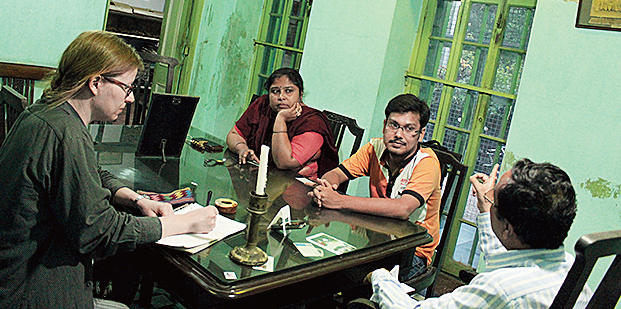Four centuries ago, the shores of the river Hugli (or, Hooghly, as it is called now), a branch of the mighty Ganges, had turned into “Little Europe”, attracting maritime traders from as many as five European nations. They set up trading posts in Barrackpore (British), Serampore (Danish), Chinsura (Dutch), Chandernagore (French) and Bandel (Portuguese). The five hinterland towns upstream from their more famous cousin, Calcutta, have been holding on to traces of Indo-European heritage in public spaces, buildings and culture. The Indo-European domestic architecture, cultural practices and memory at these five trading posts are now at extreme risk due to rapid urbanisation and need immediate conservation.
To preserve and document the heritage, the governments of UK and India have jointly funded The Hughli River of Cultures Project. A team of academic researchers who reside in and around Chandernagore and as well as partner teams from the University of Liverpool and the Indian Institute of Technology, Kharagpur, are collaborating on the research project.
In February, mostly student volunteers started photographing and interviewing owner custodians of grand heritage houses in Chandernagore. An exhibition of the photos was held at the Institute of Chandernagore in March, followed by a Heritage Fest and the launch of a book, Chandernagore Mon Amour, among other events.

Students talk to custodians of heritage structures in Chandernagore and (top) photograph one such building Photo courtesy: The Hughli River of Cultures Project

Photo courtesy: The Hughli River of Cultures Project
“It is crucial to educate young minds about the intrinsic value of their surroundings, as the knowledge of heritage value should be learned early,” says Antara Mukherjee, assistant professor of English at the Government Girls’ General Degree College in Calcutta and head of a team of student volunteers who are training to become heritage activists. “The book’s target is to instil a sense of pride in the young citizens of the town about their rich cultural and historical heritage,” adds Mukherjee, who is also the editor of the book.
At the Heritage Fest, in which students from schools and colleges in Chandernagore participated, an interactive session was held to sensitise them about the value of the town’s heritage. The schoolchildren were also taught to use a custom-made, free smartphone app — the Hugli River AR App — designed by the University of Liverpool. The app allows any location-enabled smartphone user in Chandernagore to point the camera at important houses and monuments and see, superimposed on the real-time image, a historical image taken from the same angle of that place as far back as 120 years ago. The app also carries a brief description of the heritage site.
“We went around to snap pictures of these sites from a specific angle. Some of us also spoke to the owners or custodians of these private heritage structures,” says Mayukh Sengupta, who is pursuing a master’s in History. “So far we have collected photographs and information from around 30 sites,” adds Indrajit Mandal, who has just completed a master’s in History from Rabindra Bharati University. “Unfortunately, some of the heritage structures have vanished — they’ve been demolished and replaced by multi-storeyed apartments.”
Many of the domestic buildings were demolished because inadequate finances made it impossible to maintain them. Soumyen Bandyopadhyay, co-investigator of the project and head of the School of Architecture at the University of Liverpool, says, “Economic development through cultural heritage tourism could be one of the solutions to this phenomenon of rapid urbanisation.” The purpose of the project is to provide documentation and skills to unlock many such modes of economic development, formulating a concrete heritage management strategy involving the new generation.










